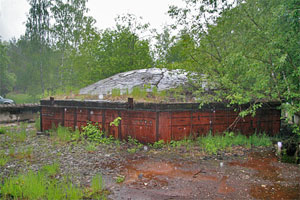Former missile launching silo now neighbors with a children’s health camp
Garages, vehicle shelters, nuclear warhead storage sites, a checkpoint, and warning signs — the town of Postavy has a rich Cold War legacy. Two decades ago, the area was occupied by the 346th strategic regiment of the 32nd missile division. Today any local citizen will eagerly show you the way to the underground launch facility, although back in the 1980s one could be thrown to prison for disclosure of classified information.
Unknown flying object
Chairman of the local executive committee Victor Gutorov accompanies me to the village of Teshelovo ten kilometers from the town. Heavy rain hopelessly devastated the trail making almost impassable. In the past, the 6-meter wide concrete road would easily hold three lanes. The road lost its ‘hard cover’ in the wild 1990s: concrete plates were perfect for paving dacha driveways.
It takes us fifteen minutes to get to the point of destination. I get out of the car to see a striking picture: a flying saucer just in front of me! Camouflaged by the grass, a rusted 80-ton iron and concrete cupola is resting on the ground. It is hard to believe that this giant thing would move along the rails and open the silo within just three seconds. The silo, packed with mechanisms and apparatuses, allowed for rapid launch of R-12 missiles stored underground. The rails were cut off, and the vertical container whose depth is comparable to a 15-storey building is gradually flooded with water. I drop a small stone into the silo for confirmation: it echoes after a while.
“We used to descend into the launch facility dressed in protective clothing and having two gas masks with us — a usual one and a self-contained breathing apparatus. Only officers and ensigns were allowed to service R12, short-term soldiers fulfilled auxiliary functions,” says Yuri Shushunov, head of the electric fire brigade of the 2nd and 3rd deployment and launch group.
Combat alert missions would last for a week. Everyone was assigned to a certain level of which there were four. The higher one housed a vertical elevator and assembly sites.
“Four combat brigades were engaged in missile deployment. The first one targeted the missile, the second one set up the engine, the third adjusted graphite fins, and the fourth would connect high-voltage cables. I remember special commands such as ‘Silence on the missile! The third brigade is on duty,” recollects Yuri Shushunov.
A legendary village
My counterpart is telling about the things he is well familiar with. In 1966-1968 he took part in launching R-12 in the Kapustin Yar rocket launch site. After a missile took off and headed for the target, soldiers would place their thumbs against the sooty launcher and put a fingerprint in their military credentials. The relic would be kept with care and affection.
Between four equidistant silos there is a pillbox. Underneath is the operations control post situated at a depth of a three-storey building. For an ordinary person it is difficult to get into the post as it is locked and filled with water. Hidden under wooden cabins, the silos were hard to identify. When viewed from above, the area did not differ from the nearby villages.
Unfortunately, these magnificent constructions cannot be used now, even as tourist attractions as devastated metal constructions, damaged wires and dilapidated brick walls make the silos dangerous.
Buy-buy, rockets
Our next destination is Vetraz children’s camp. Before going there we turn to a small rural road that leads us to the former division’s repair and overhaul facility. After removal of the missiles the territory has been used by entrepreneurs who bought the premises to run a recycling business.
The car pulls over at the checkpoint. Wу can see a dappled dog, a rusted gate and piles of packed garbage. Soldiers who marched on the hardstand and serviced vehicles in huge garages would be surprised to see what te territory looks like today. Hangars, armament storage facilities, missile cranes and signs ‘Make sure that the cargo is securely attached’ are the only things here that remind of the military past.
We move to the former training center of the 32nd missile division. It welcomes us with children’s laughter. In 2004, the military building was transformed into a health center. After missile removal the training center could have been transformed into a prison, and even a group of convicts were brought there. Later, fortunately, the idea was given up.
“About 1,000 soldiers lived in three barracks. Now these premises house children’s sleeping rooms. We didn’t have to do an overall redecoration as conditions in which soldiers lived were quite comfortable,” Vladimir Nikiforov, chief doctor of the health center, formerly senior medical officer of the division’s repair and overhaul unit, is showing me around the camp area.
Commanders’ museum
Garages where Pioneer missiles were previously stored are now maintained by the health center’s motorcar unit. The missile regiment houses the resort’s administration and a hotel, a school building was converted into a medical facility for young patients. The former soldiers’ club is now used as an entertainment center where guests come to watch movies or dance. The canteen is also used as initially intended.
“The two-storey hotel for officers and ensigns will be soon rebuilt. The operation command post will be turned into a museum of missile troops,” says Vladimir Nikiforov.
Military village No. 5 where officers and their families lived is the last stop of our ‘missile’ tour. People say that the location was so secret that even a chairman of the local party committee needed a special pass to enter the village. Presently the place is open for visiting. On the site of the former checkpoint there is a food store, the division headquarters now house a border command post, barracks are rented by businessmen. Day by day, peaceful life wins increasingly more space from once a menacing strategic object.











